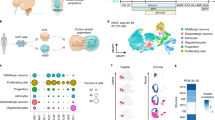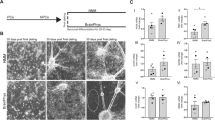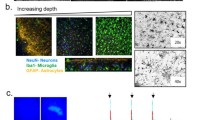Abstract
Primary cultures of rat and murine hippocampal neurons are widely used to reveal cellular mechanisms in neurobiology. Their use is limited, as culturing at low density is often not possible or is dependent on sophisticated methods. Here we present a novel method for culturing embryonic (E16.5) murine hippocampal neurons, using a spatially separated ring of cortical neurons for neurotrophic support. This method allows long-term cultures at a very low cell density, and therefore, the study of single embryo preparations and isolated neurons. This method has been adopted for neurons from the substantia nigra (E16.5), with support from a ring of striatal neurons.
This is a preview of subscription content, access via your institution
Access options
Subscribe to this journal
Receive 12 print issues and online access
$259.00 per year
only $21.58 per issue
Buy this article
- Purchase on Springer Link
- Instant access to full article PDF
Prices may be subject to local taxes which are calculated during checkout







Similar content being viewed by others
References
Banker, G. & Goslin, K. Culturing Nerve Cells, (MIT Press, Cambridge, 1998).
Plachta, N. et al. Identification of a lectin causing the degeneration of neuronal processes using engineered embryonic stem cells. Nat. Neurosci. 10, 712–719 (2007).
Bibel, M., Richter, J., Lacroix, E. & Barde, Y.A. Generation of a defined and uniform population of CNS progenitors and neurons from mouse embryonic stem cells. Nat. Protoc. 2, 1034–1043 (2007).
Lee, H.Y. et al. Instructive role of Wnt/beta-catenin in sensory fate specification in neural crest stem cells. Science 303, 1020–1023 (2004).
Kleber, M. et al. Neural crest stem cell maintenance by combinatorial Wnt and BMP signaling. J. Cell Biol. 169, 309–320 (2005).
Ackermann, M. & Matus, A. Activity-induced targeting of profilin and stabilization of dendritic spine morphology. Nat. Neurosci. 6, 1194–1200 (2003).
Fischer, M., Kaech, S., Knutti, D. & Matus, A. Rapid actin-based plasticity in dendritic spines. Neuron 20, 847–854 (1998).
Calabrese, B. & Halpain, S. Essential role for the PKC target MARCKS in maintaining dendritic spine morphology. Neuron 48, 77–90 (2005).
Minamide, L.S., Striegl, A.M., Boyle, J.A., Meberg, P.J. & Bamburg, J.R. Neurodegenerative stimuli induce persistent ADF/cofilin-actin rods that disrupt distal neurite function. Nat. Cell Biol. 2, 628–636 (2000).
Banker, G.A. & Cowan, W.M. Rat hippocampal neurons in dispersed cell culture. Brain Res. 126, 397–342 (1977).
Raineteau, O., Rietschin, L., Gradwohl, G., Guillemot, F. & Gahwiler, B.H. Neurogenesis in hippocampal slice cultures. Mol. Cell Neurosci. 26, 241–250 (2004).
Banker, G.A. Trophic interactions between astroglial cells and hippocampal neurons in culture. Science 209, 809–810 (1980).
Dotti, C.G., Sullivan, C.A. & Banker, G.A. The establishment of polarity by hippocampal neurons in culture. J. Neurosci. 8, 1454–1468 (1988).
Kaech, S. & Banker, G. Culturing hippocampal neurons. Nat. Protoc. 1, 2406–2415 (2006).
Ittner, L.M. et al. Parkinsonism and impaired axonal transport in a mouse model of frontotemporal dementia. PNAS 105, 15997–16002 (2008).
Kurosinski, P., Guggisberg, M. & Gotz, J. Alzheimer's and Parkinson's disease—overlapping or synergistic pathologies? Trends Mol. Med. 8, 3–5 (2002).
Rayport, S. et al. Identified postnatal mesolimbic dopamine neurons in culture: morphology and electrophysiology. J. Neurosci. 12, 4264–4280 (1992).
Cardozo, D.L. Midbrain dopaminergic neurons from postnatal rat in long-term primary culture. Neuroscience 56, 409–421 (1993).
Shi, W.X. & Rayport, S. GABA synapses formed in vitro by local axon collaterals of nucleus accumbens neurons. J. Neurosci. 14, 4548–4560 (1994).
Sulzer, D. et al. Dopamine neurons make glutamatergic synapses in vitro . J. Neurosci. 18, 4588–4602 (1998).
Congar, P., Bergevin, A. & Trudeau, L.E. D2 receptors inhibit the secretory process downstream from calcium influx in dopaminergic neurons: implication of K+ channels. J. Neurophysiol. 87, 1046–1056 (2002).
Gille, G. et al. Pergolide protects dopaminergic neurons in primary culture under stress conditions. J. Neural Transm. 109, 633–643 (2002).
Hamann, J., Rommelspacher, H., Storch, A., Reichmann, H. & Gille, G. Neurotoxic mechanisms of 2,9-dimethyl-beta-carbolinium ion in primary dopaminergic culture. J. Neurochem. 98, 1185–1199 (2006).
Poulsen, K.T. et al. TGF beta 2 and TGF beta 3 are potent survival factors for midbrain dopaminergic neurons. Neuron 13, 1245–1252 (1994).
Wurdak, H. et al. Inactivation of TGFbeta signaling in neural crest stem cells leads to multiple defects reminiscent of DiGeorge syndrome. Genes Dev. 19, 530–535 (2005).
Ittner, L.M. et al. Compound developmental eye disorders following inactivation of TGFbeta signaling in neural-crest stem cells. J. Biol. 4, 11 (2005).
Massague, J. How cells read TGF-beta signals. Nat. Rev. Mol. Cell Biol. 1, 169–178 (2000).
Farkas, L.M., Dunker, N., Roussa, E., Unsicker, K. & Krieglstein, K. Transforming growth factor-beta(s) are essential for the development of midbrain dopaminergic neurons in vitro and in vivo . J. Neurosci. 23, 5178–5186 (2003).
Ittner, L.M. & Gotz, J. Pronuclear injection for the production of transgenic mice. Nat. Protoc. 2, 1206–1215 (2007).
Acknowledgements
We thank Mian Bi, Fabien Delerue and Denise Nergenau for technical assistance and Dr Victor Anggono for the dynamin antibody. L.M.I. has been supported by the DFG, the Australian Research Council (ARC) and the University of Sydney. J.G. is a Medical Foundation Fellow and has been supported by the University of Sydney, the National Health and Medical Research Council (NHMRC), the ARC, the New South Wales Government through the Ministry for Science and Medical Research (BioFirst Program), the Nerve Research Foundation, the Medical Foundation (University of Sydney) and the Judith Jane Mason and Harold Stannett Williams Memorial Foundation. P.G. is supported by a NSW cancer institute research infrastructure grant and is a Principal Research Fellow of the NHMRC.
Author information
Authors and Affiliations
Corresponding authors
Rights and permissions
About this article
Cite this article
Fath, T., Ke, Y., Gunning, P. et al. Primary support cultures of hippocampal and substantia nigra neurons. Nat Protoc 4, 78–85 (2009). https://doi.org/10.1038/nprot.2008.199
Published:
Issue Date:
DOI: https://doi.org/10.1038/nprot.2008.199
This article is cited by
-
Rasal1 regulates calcium dependent neuronal maturation by modifying microtubule dynamics
Cell & Bioscience (2024)
-
Clinical relevance of animal models in aging-related dementia research
Nature Aging (2023)
-
Ketamine exerts dual effects on the apoptosis of primary cultured hippocampal neurons from fetal rats in vitro
Metabolic Brain Disease (2023)
-
Hypoxia-Induced Neurite Outgrowth Involves Regulation Through TRPM7
Molecular Neurobiology (2023)
-
mRNA trans-splicing dual AAV vectors for (epi)genome editing and gene therapy
Nature Communications (2023)
Comments
By submitting a comment you agree to abide by our Terms and Community Guidelines. If you find something abusive or that does not comply with our terms or guidelines please flag it as inappropriate.



